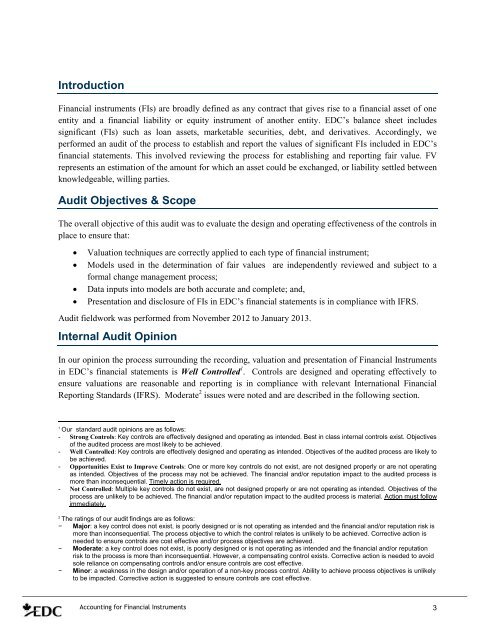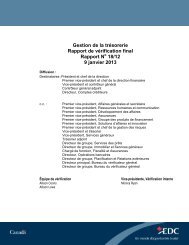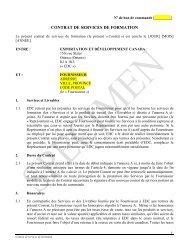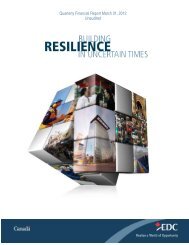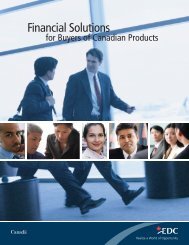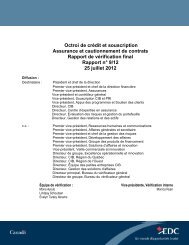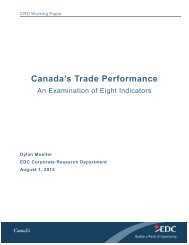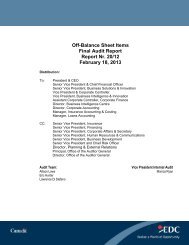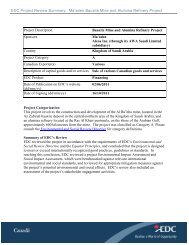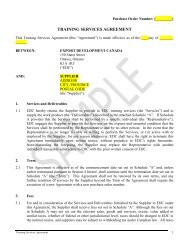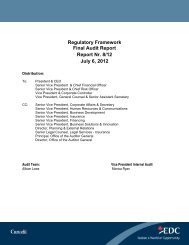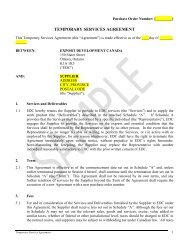Accounting for Financial Instruments - Final Audit Report ... - EDC
Accounting for Financial Instruments - Final Audit Report ... - EDC
Accounting for Financial Instruments - Final Audit Report ... - EDC
You also want an ePaper? Increase the reach of your titles
YUMPU automatically turns print PDFs into web optimized ePapers that Google loves.
Introduction<strong>Financial</strong> instruments (FIs) are broadly defined as any contract that gives rise to a financial asset of oneentity and a financial liability or equity instrument of another entity. <strong>EDC</strong>’s balance sheet includessignificant (FIs) such as loan assets, marketable securities, debt, and derivatives. Accordingly, weper<strong>for</strong>med an audit of the process to establish and report the values of significant FIs included in <strong>EDC</strong>’sfinancial statements. This involved reviewing the process <strong>for</strong> establishing and reporting fair value. FVrepresents an estimation of the amount <strong>for</strong> which an asset could be exchanged, or liability settled betweenknowledgeable, willing parties.<strong>Audit</strong> Objectives & ScopeThe overall objective of this audit was to evaluate the design and operating effectiveness of the controls inplace to ensure that:Valuation techniques are correctly applied to each type of financial instrument;Models used in the determination of fair values are independently reviewed and subject to a<strong>for</strong>mal change management process;Data inputs into models are both accurate and complete; and,Presentation and disclosure of FIs in <strong>EDC</strong>’s financial statements is in compliance with IFRS.<strong>Audit</strong> fieldwork was per<strong>for</strong>med from November 2012 to January 2013.Internal <strong>Audit</strong> OpinionIn our opinion the process surrounding the recording, valuation and presentation of <strong>Financial</strong> <strong>Instruments</strong>in <strong>EDC</strong>’s financial statements is Well Controlled 1 . Controls are designed and operating effectively toensure valuations are reasonable and reporting is in compliance with relevant International <strong>Financial</strong><strong>Report</strong>ing Standards (IFRS). Moderate 2 issues were noted and are described in the following section.1Our standard audit opinions are as follows:- Strong Controls: Key controls are effectively designed and operating as intended. Best in class internal controls exist. Objectivesof the audited process are most likely to be achieved.- Well Controlled: Key controls are effectively designed and operating as intended. Objectives of the audited process are likely tobe achieved.- Opportunities Exist to Improve Controls: One or more key controls do not exist, are not designed properly or are not operatingas intended. Objectives of the process may not be achieved. The financial and/or reputation impact to the audited process ismore than inconsequential. Timely action is required.- Not Controlled: Multiple key controls do not exist, are not designed properly or are not operating as intended. Objectives of theprocess are unlikely to be achieved. The financial and/or reputation impact to the audited process is material. Action must followimmediately.2The ratings of our audit findings are as follows:− Major: a key control does not exist, is poorly designed or is not operating as intended and the financial and/or reputation risk ismore than inconsequential. The process objective to which the control relates is unlikely to be achieved. Corrective action isneeded to ensure controls are cost effective and/or process objectives are achieved.− Moderate: a key control does not exist, is poorly designed or is not operating as intended and the financial and/or reputationrisk to the process is more than inconsequential. However, a compensating control exists. Corrective action is needed to avoidsole reliance on compensating controls and/or ensure controls are cost effective.− Minor: a weakness in the design and/or operation of a non-key process control. Ability to achieve process objectives is unlikelyto be impacted. Corrective action is suggested to ensure controls are cost effective.<strong>Accounting</strong> <strong>for</strong> <strong>Financial</strong> <strong>Instruments</strong> 3


